
Many survival adventures Archives

many survival adventures Archives
survival skills

| Ford Church
CAP Alumni Spotlight: Peter Zola
We caught up with Peter Zola, an amazing Community Adventure Program (CAP) student alumni from New Vista High School in Boulder, CO who is now 31 years old. He was gracious enough to fill us in on what he’s up to these days. Of course, he’s still “Livin’ the Dream!” as our Executive Director, Ford… Read more »
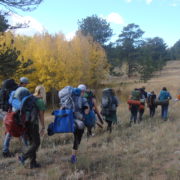
| Sarah Rudeen
CAP New Vista Builds Shelter and Lasting Friendships
The fall semester is flying by and this weekend was CAP New Vista‘s final camping trip together as a group! After a quick gear check in Boulder on Saturday morning, we arrived at a camping spot near Taylor Mountain in Allenspark, CO. While the hike in was less than two miles, it was a great… Read more »

| Sarah Rudeen
Denver Green School CAP Enjoys Colorado’s Autumn Beauty
Recently, the two Denver Green School Community Adventure Program (CAP) classes went on an overnight camping trip at Cheley Outpost Camp near Allenspark, CO. Having the opportunity to go on a camping trip is not common in most schools. Some of us had gone camping before, but this trip was different than any other. Overall, Cottonwood Institute provided us with… Read more »
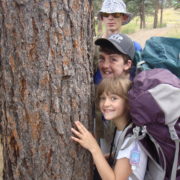
| Sarah Rudeen
Teamwork, Fun, and Survival Skills with Military Kids and Families
Since 2010, Cottonwood Institute has been collaborating with the military community along the Colorado Front Range to offer our Military Kids Project. We are honored to make this program possible for active military families and their children to thank them for their incredible service and sacrifice they make for our country. With a small but mighty… Read more »
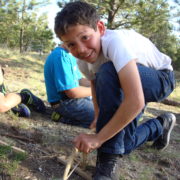
| Sarah Rudeen
Leaving It All Behind: Littleton Academy at Mission: Wolf
Gear flung everywhere, smiles abound, and parents left behind! It’s time for an adventure! Twenty-one Littleton Academy 5th graders and six adults headed out to howl with the wolves this past week at Mission: Wolf, a wolf sanctuary hidden in the shadows of the beautiful Sangre de Cristo Mountains just outside of Gardner, Colorado. For… Read more »
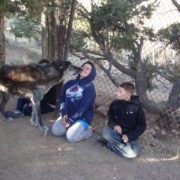
| Sarah Rudeen
Meeting Wolves with New Eyes: STRIVE Prep-Sunnyside
It was a clear, sunny day when twelve STRIVE Prep – Sunnyside students embarked on a journey into the Sangre de Cristo mountains. They had one clear mission: to meet and learn about wolves in the remote mountain sanctuary aptly named Mission: Wolf. The group had bountiful energy and enthusiasm; their four hour drive to the site… Read more »
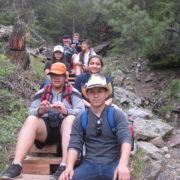
| Sarah Rudeen
The Hunger Games: CI-Style with STRIVE Prep-Excel CAP Students
It all started out a week before our trip. During class we went outside and had a 10 Hiking Essentials Relay Race, with each team racing toward a pile of random supplies and stuffing items inside. Points were awarded for speed and relevance of the items that ended up in the packs. (Do you really… Read more »
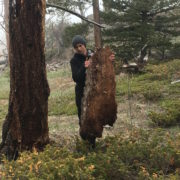
| Sarah Rudeen
A Rainy Pondside Retreat with New Vista CAP Students
Six New Vista High School Community Adventure Program (CAP) students and three instructors braved the wet weather as we left Boulder heading toward Allenspark. When we arrived at the trailhead, the sun was shining through the clouds and it ended up being a great day for our hike near Taylor Mountain. Instructors gathered our group to… Read more »

| Sarah Rudeen
KIPP Montbello Students Singin’ in the Snow
“It’s beginning to look a lot like Christmas,” twenty-plus Kippsters harmonized in the snow at the beginning of May. As many of us know, flexibility is the key word in education and we got to practice that with the abrupt change of venue for the Spring overnight trip for Community Adventure Program (CAP) students at KIPP… Read more »
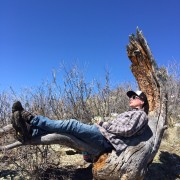
| Ford Church
CAP Students Living in the Moment
Snug as a bug, students packed in among backpacks and gear, eager to see what awaited them on their new adventure. This last weekend the Community Adventure Program (CAP) of New Vista High School headed to beautiful Cal-wood Education Center near Jamestown, CO. They were met with snowy hilltops and sunshine bright enough to create lots of rosy sun-kissed cheeks…. Read more »
Survival horror
Survival horror is a subgenre of action-adventure and horror video games that focuses on survival of the character as the game tries to frighten players with either horror graphics or scary ambience. Although combat can be part of the gameplay, the player is made to feel less in control than in typical action games through limited ammunition, health, speed and vision, or through various obstructions of the player's interaction with the game mechanics. The player is also challenged to find items that unlock the path to new areas and solve puzzles to proceed in the game. Games make use of strong horror themes, like dark mazelike environments and unexpected attacks from enemies.
The term "survival horror" was first used for the original Japanese release of Resident Evil in 1996, which was influenced by earlier games with a horror theme such as 1989's Sweet Home and 1992's Alone in the Dark. The name has been used since then for games with similar gameplay, and has been retroactively applied to earlier titles. Starting with the release of Resident Evil 4 in 2005, the genre began to incorporate more features from action games and more traditional first person and third-person shooter games. This has led game journalists to question whether long-standing survival horror franchises and more recent franchises have abandoned the genre and moved into a distinct genre often referred to as "action horror".[1][2][3][4]
Definition[edit]

Survival horror refers to a subgenre of action-adventurevideo games that include horror game elements.[5][6][7] The player character is vulnerable and under-armed,[8] which puts emphasis on puzzle-solving and evasion, rather than the player taking an offensive strategy.[9] Games commonly challenge the player to manage their inventory[10] and ration scarce resources such as ammunition.[8][9] Another major theme throughout the genre is that of isolation. Typically, these games contain relatively few non-player characters and, as a result, frequently tell much of their story second-hand through the usage of journals, texts, or audio logs.[11]
While many action games feature lone protagonists versus swarms of enemies in a suspenseful environment,[12] survival horror games are distinct from otherwise horror-themed action games.[13][14] They tend to de-emphasize combat in favor of challenges such as hiding or running from enemies and solving puzzles.[12] Still, it is not unusual for survival horror games to draw upon elements from first-person shooters, action-adventure games, or even role-playing games.[5] According to IGN, "Survival horror is different from typical game genres in that it is not defined strictly by specific mechanics, but subject matter, tone, pacing, and design philosophy."[11]
Game design[edit]
De-emphasized combat[edit]
Survival horror games are a subgenre of horror games,[6] where the player is unable to fully prepare or arm their avatar.[8] The player usually encounters several factors to make combat unattractive as a primary option, such as a limited number of weapons or invulnerable enemies;[15] if weapons are available, their ammunition is sparser than in other games,[16] and powerful weapons such as rocket launchers are rare, if even available at all.[8] Thus, players are more vulnerable than in action games,[8] and the hostility of the environment sets up a narrative where the odds are weighed decisively against the avatar.[5] This shifts gameplay away from direct combat, and players must learn to evade enemies or turn the environment against them.[12] Games try to enhance the experience of vulnerability by making the game single-player rather than multiplayer,[15] and by giving the player an avatar who is more frail than the typical action game hero.[16]
The survival horror genre is also known for other non-combat challenges, such as solving puzzles at certain locations in the game world,[12] and collecting and managing an inventory of items.[17] Areas of the game world will be off limits until the player gains certain items. Occasionally, levels are designed with alternative routes.[10] Levels also challenge players with mazelike environments, which test the player's navigational skills.[12] Levels are often designed as dark and claustrophobic (often making use of dim or shadowy light conditions and camera angles and sightlines which restrict visibility) to challenge the player and provide suspense,[8][18] although games in the genre also make use of enormous spatial environments.[5]
Enemy design[edit]
A survival horror storyline usually involves the investigation and confrontation of horrific forces,[19] and thus many games transform common elements from horror fiction into gameplay challenges.[8] Early releases used camera angles seen in horror films, which allowed enemies to lurk in areas that are concealed from the player's view.[20] Also, many survival horror games make use of off-screen sound or other warning cues to notify the player of impending danger. This feedback assists the player, but also creates feelings of anxiety and uncertainty.[19]
Games typically feature a variety of monsters with unique behavior patterns.[10] Enemies can appear unexpectedly or suddenly,[8] and levels are often designed with scripted sequences where enemies drop from the ceiling or crash through windows.[18] Survival horror games, like many action-adventure games, are sometimes structured around the boss encounter where the player must confront a formidable opponent in order to advance to the next area. These boss encounters draw elements from antagonists seen in classic horror stories, and defeating the boss will advance the story of the game.
History[edit]
Origins (1980s–1996)[edit]
The origins of the survival horror game can be traced back to earlier horror fiction. Archetypes have been linked to the books of H. P. Lovecraft, which include investigative narratives, or journeys through the depths. Comparisons have been made between Lovecraft's Great Old Ones and the boss encounters seen in many survival horror games. Themes of survival have also been traced to the slasher film subgenre, where the protagonist endures a confrontation with the ultimate antagonist.[5] Another major influence on the genre is Japanese horror, including classical Nohtheatre, the books of Edogawa Rampo,[21] and Japanese cinema.[22] The survival horror genre largely draws from both Western (mainly American) and Asian (mainly Japanese) traditions,[22] with the Western approach to horror generally favoring action-oriented visceral horror while the Japanese approach tends to favour psychological horror.[12]
Nostromo was a survival horror game developed by Akira Takiguchi, a Tokyo University student and Taito contractor, for the PET 2001. It was ported to the PC-6001 by Masakuni Mitsuhashi (also known as Hiromi Ohba, later joined Game Arts), and published by ASCII in 1981, exclusively for Japan. Inspired by the 1979 Japanese only stealth gameManbiki Shounen (Shoplifting Boy) by Hiroshi Suzuki and the 1979 sci-fi horror film Alien, the gameplay of Nostromo involved a player attempting to escape a spaceship while avoiding the sight of an invisible alien, which only becomes visible when appearing in front of the player. The gameplay also involved limited resources, where the player needs to collect certain items in order to escape the ship, and if certain required items are not available in the warehouse, the player is unable to escape and eventually has no choice but be killed getting caught by the alien.[23]
Another early example is the 1982 Atari 2600 game Haunted House. Gameplay is typical of future survival horror titles, as it emphasizes puzzle-solving and evasive action, rather than violence.[9] The game uses creatures commonly featured in horror fiction, such as bats and ghosts, each of which has unique behaviors. Gameplay also incorporates item collection and inventory management, along with areas that are inaccessible until the appropriate item is found. Because it has several features that have been seen in later survival horror games, some reviewers have retroactively classified this game as the first in the genre.[10]
Malcolm Evans' 3D Monster Maze, released for the Sinclair ZX81 in 1982,[24] is a first-person game without a weapon; the player cannot fight the enemy, a Tyrannosaurus rex, so he must escape by finding the exit before the monster finds him. The game states its distance and awareness of the player, further raising tension. Edge stated it was about "fear, panic, terror and facing an implacable, relentless foe who’s going to get you in the end" and considers it "the original survival horror game".[25]Retro Gamer stated, "Survival horror may have been a phrase first coined by Resident Evil, but it could’ve easily applied to Malcolm Evans’ massive hit."[26]
1982 saw the release of another early horror game, Bandai's Terror House,[27] based on traditional Japanese horror,[28] released as a Bandai LCD Solarpowerhandheld game. It was a solar-powered game with two LCD panels on top of each other to enable impressive scene changes and early pseudo-3D effects.[29] The amount of ambient light the game received also had an effect on the gaming experience.[30] Another early example of a horror game released that year was Sega's arcade gameMonster Bash, which introduced classic horror-movie monsters, including the likes of Dracula, Frankenstein's monster, and werewolves, helping to lay the foundations for future survival horror games.[31] Its 1986 remake Ghost House had gameplay specifically designed around the horror theme, featuring haunted house stages full of traps and secrets, and enemies that were fast, powerful, and intimidating, forcing players to learn the intricacies of the house and rely on their wits.[11] Another game that has been cited as one of the first horror-themed games is Quicksilva's 1983 maze game Ant Attack.[32]
The latter half of the 1980s saw the release of several other horror-themed games, including Konami's Castlevania in 1986, and Sega's Kenseiden and Namco's Splatterhouse in 1988, though despite the macabre imagery of these games, their gameplay did not diverge much from other action games at the time.[11]Splatterhouse in particular is notable for its large amount of bloodshed and terror, despite being an arcade beat 'em up with very little emphasis on survival.[33]
Shiryou Sensen: War of the Dead, a 1987 title developed by Fun Factory and published by Victor Music Industries for the MSX2, PC-88 and PC Engine platforms,[34] is considered the first true survival horror game by Kevin Gifford (of GamePro and 1UP)[35] and John Szczepaniak (of Retro Gamer and The Escapist).[34] Designed by Katsuya Iwamoto, the game was a horror action RPG revolving around a female SWAT member Lila rescuing survivors in an isolated monster-infested town and bringing them to safety in a church. It has open environments like Dragon Quest and real-time side-view battles like Zelda II, though War of the Dead departed from other RPGs with its dark and creepy atmosphere expressed through the storytelling, graphics, and music.[35] The player character has limited ammunition, though the player character can punch or use a knife if out of ammunition. The game also has a limited item inventory and crates to store items, and introduced a day-night cycle; the player can sleep to recover health, and a record is kept of how many days the player has survived.[34] In 1988, War of the Dead Part 2 for the MSX2 and PC-88 abandoned the RPG elements of its predecessor, such as random encounters, and instead adopted action-adventure elements from Metal Gear while retaining the horror atmosphere of its predecessor.[34]
However, the game often considered the first true survival horror, due to having the most influence on Resident Evil, was the 1989 release Sweet Home, for the Nintendo Entertainment System.[36] It was created by Tokuro Fujiwara, who would later go on to create Resident Evil.[37]Sweet Home's gameplay focused on solving a variety of puzzles using items stored in a limited inventory,[38] while battling or escaping from horrifying creatures, which could lead to permanent death for any of the characters, thus creating tension and an emphasis on survival.[38] It was also the first attempt at creating a scary and frightening storyline within a game, mainly told through scattered diary entries left behind fifty years before the events of the game.[39] Developed by Capcom, the game would become the main inspiration behind their later release Resident Evil.[36][38] Its horrific imagery prevented its release in the Western world, though its influence was felt through Resident Evil, which was originally intended to be a remake of the game.[40] Some consider Sweet Home to be the first true survival horror game.[41]
In 1989, Electronic Arts published Project Firestart, developed by Dynamix. Unlike most other early games in the genre, it featured a science fiction setting inspired by the film Alien, but had gameplay that closely resembled later survival horror games in many ways. Travis Fahs considers it the first to achieve "the kind of fully formed vision of survival horror as we know it today," citing its balance of action and adventure, limited ammunition, weak weaponry, vulnerable main character, feeling of isolation, storytelling through journals, graphic violence, and use of dynamically triggered music - all of which are characteristic elements of later games in the survival horror genre. Despite this, it is not likely a direct influence on later games in the genre and the similarities are largely an example of parallel thinking.[11]

In 1992, Infogrames released Alone in the Dark, which has been considered a forefather of the genre.[10][42][43] The game featured a lone protagonist against hordes of monsters, and made use of traditional adventure game challenges such as puzzle-solving and finding hidden keys to new areas. Graphically, Alone in the Dark uses static prerendered camera views that were cinematic in nature. Although players had the ability to fight monsters as in action games, players also had the option to evade or block them.[6] Many monsters could not be killed, and thus could only be dealt with using problem-solving abilities.[44] The game also used the mechanism of notes and books as expository devices.[9] Many of these elements were used in later survival horror games, and thus the game is credited with making the survival horror genre possible.[6]
In 1994, Riverhillsoft released Doctor Hauzer for the 3DO. Both the player character and the environment are rendered in polygons. The player can switch between three different perspectives: third-person, first-person, and overhead. In a departure from most survival horror games, Doctor Hauzer lacks any enemies; the main threat is instead the sentient house that the game takes place in, with the player having to survive the house's traps and solve puzzles. The sound of the player character's echoing footsteps change depending on the surface.[45]
In 1995, WARP's horror adventure game D featured a first-person perspective, CGIfull-motion video, gameplay that consisted entirely of puzzle-solving, and taboo content such as cannibalism.[46][47] The same year, Human Entertainment's Clock Tower was a survival horror game that employed point-and-clickgraphic adventure gameplay and a deadly stalker known as Scissorman that chases players throughout the game.[48] The game introduced stealth game elements,[49] and was unique for its lack of combat, with the player only able to run away or outsmart Scissorman in order to survive. It features up to nine different possible endings.[50]
The term "survival horror" was first used by Capcom to market their 1996 release, Resident Evil.[51][52] It began as a remake of Sweet Home,[40] borrowing various elements from the game, such as its mansion setting, puzzles, "opening door" load screen,[38][36] death animations, multiple endings depending on which characters survive,[39] dual character paths, individual character skills, limited item management, story told through diary entries and frescos, emphasis on atmosphere, and horrific imagery.[40]Resident Evil also adopted several features seen in Alone in the Dark, notably its cinematic fixed camera angles and pre-rendered backdrops.[53] The control scheme in Resident Evil also became a staple of the genre, and future titles imitated its challenge of rationing very limited resources and items.[9] The game's commercial success is credited with helping the PlayStation become the dominant game console,[6] and also led to a series of Resident Evil films.[5] Many games have tried to replicate the successful formula seen in Resident Evil, and every subsequent survival horror game has arguably taken a stance in relation to it.[5]
Golden age (1996–2004)[edit]
The success of Resident Evil in 1996 was responsible for its template being used as the basis for a wave of successful survival horror games, many of which were referred to as "Resident Evil clones."[54] The golden age of survival horror started by Resident Evil reached its peak around the turn of the millennium with Silent Hill, followed by a general decline a few years later.[54] Among the Resident Evil clones at the time, there were several survival horror titles that stood out, such as Clock Tower (1996) and Clock Tower II: The Struggle Within (1998) for the PlayStation. These Clock Tower games proved to be hits, capitalizing on the success of Resident Evil while staying true to the graphic-adventure gameplay of the original Clock Tower rather than following the Resident Evil formula.[48] Another survival horror title that differentiated itself was Corpse Party (1996), an indie, psychological horroradventure game created using the RPG Maker engine. Much like Clock Tower and later Haunting Ground (2005), the player characters in Corpse Party lack any means of defending themselves; the game also featured up to 20 possible endings. However, the game would not be released in Western markets until 2011.[55] Another game similar to the Clock Tower series of games and Haunting Ground, which was also inspired by Resident Evil's success is the Korean game known as White Day: A Labyrinth Named School (2001). This game was reportedly so scary that the developers had to release several patches adding multiple difficulty options, and the game was slated for localization in 2004 but was cancelled. Building on its previous success in Korea and interest, a remake has been developed in 2015.[56][57]Riverhillsoft's Overblood, released in 1996, is considered the first survival horror game to make use of a fully three-dimensional virtual environment.[5]The Note in 1997 and Hellnight in 1998 experimented with using a real-time 3D first-person perspective rather than pre-rendered backgrounds like Resident Evil.[48]
In 1998, Capcom released the successful sequel Resident Evil 2, which series creator Shinji Mikami intended to tap into the classic notion of horror as "the ordinary made strange," thus rather than setting the game in a creepy mansion no one would visit, he wanted to use familiar urban settings transformed by the chaos of a viral outbreak. The game sold over five million copies, proving the popularity of survival horror. That year saw the release of Square's Parasite Eve, which combined elements from Resident Evil with the RPG gameplay of Final Fantasy. It was followed by a more action-based sequel, Parasite Eve II, in 1999.[48] In 1998, Galerians discarded the use of guns in favour of psychic powers that make it difficult to fight more than one enemy at a time.[58] Also in 1998, Blue Stinger was a fully 3D survival horror game for the Dreamcast incorporating action elements from beat 'em up and shooter games.[59][60]
Konami's Silent Hill, released in 1999, drew heavily from Resident Evil while using real-time 3D environments in contrast to Resident Evil's pre-rendered graphics.[61]Silent Hill in particular was praised for moving away from B movie horror elements to the psychological style seen in art house or Japanese horror films,[5] due to the game's emphasis on a disturbing atmosphere rather than visceral horror.[62] The game also featured stealth elements, making use of the fog to dodge enemies or turning off the flashlight to avoid detection.[63] The original Silent Hill is considered one of the scariest games of all time,[64] and the strong narrative from Silent Hill 2 in 2001 has made the Silent Hill series one of the most influential in the genre.[9] According to IGN, the "golden age of survival horror came to a crescendo" with the release of Silent Hill.[48]
Also in 1999, Capcom released the original Dino Crisis, which was noted for incorporating certain elements from survival horror games. It was followed by a more action-based sequel, Dino Crisis 2, in 2000.
Fatal Frame from 2001 was a unique entry into the genre, as the player explores a mansion and takes photographs of ghosts in order to defeat them.[44][65] The Fatal Frame series has since gained a reputation as one of the most distinctive in the genre,[66] with the first game in the series credited as one of the best-written survival horror games ever made, by UGO Networks.[65] Meanwhile, Capcom incorporated shooter elements into several survival horror titles, such as 2000's Resident Evil Survivor which used both light gun shooter and first-person shooter elements, and 2003's Resident Evil: Dead Aim which used light gun and third-person shooter elements.[67]
Western developers began to return to the survival horror formula.[9]The Thing from 2002 has been called a survival horror game, although it is distinct from other titles in the genre due to its emphasis on action, and the challenge of holding a team together.[68] The 2004 title Doom 3 is sometimes categorized as survival horror, although it is considered an Americanized take on the genre due to the player's ability to directly confront monsters with weaponry.[44] Thus, it is usually considered a first-person shooter with survival horror elements.[69] Regardless, the genre's increased popularity led Western developers to incorporate horror elements into action games, rather than follow the Japanese survival style.[9]
Overall, the traditional survival horror genre continued to be dominated by Japanese designers and aesthetics.[9] 2002's Clock Tower 3 eschewed the graphic adventure game formula seen in the original Clock Tower, and embraced full 3D survival horror gameplay.[9][70] In 2003, Resident Evil Outbreak introduced a new gameplay element to the genre: onlinemultiplayer and cooperative gameplay.[71][72]Sony employed Silent Hill director Keiichiro Toyama to develop Siren.[9] The game was released in 2004,[73] and added unprecedented challenge to the genre by making the player mostly defenseless, thus making it vital to learn the enemy's patrol routes and hide from them.[74] However, reviewers eventually criticized the traditional Japanese survival horror formula for becoming stagnant.[9] As the console market drifted towards Western-style action games,[12] players became impatient with the limited resources and cumbersome controls seen in Japanese titles such as Resident Evil Code: Veronica and Silent Hill 4: The Room.[9]
Transformation (2005–present)[edit]

In 2005, Resident Evil 4 attempted to redefine the genre by emphasizing reflexes and precision aiming,[75] broadening the gameplay with elements from the wider action genre.[76] Its ambitions paid off, earning the title several Game of the Year awards for 2005,[77][78] and the top rank on IGN's Readers' Picks Top 99 Games list.[79] However, this also led some reviewers to suggest that the Resident Evil series had abandoned the survival horror genre,[42][80] by demolishing the genre conventions that it had established.[9] Other major survival horror series followed suit by developing their combat systems to feature more action, such as Silent Hill Homecoming,[42] and the 2008 version of Alone in the Dark.[81] These changes were part of an overall trend among console games to shift towards visceral action gameplay.[12] These changes in gameplay have led some purists to suggest that the genre has deteriorated into the conventions of other action games.[12][42]Jim Sterling suggests that the genre lost its core gameplay when it improved the combat interface, thus shifting the gameplay away from hiding and running towards direct combat.[42] Leigh Alexander argues that this represents a shift towards more Western horror aesthetics, which emphasize action and gore rather than the psychological experience of Japanese horror.[12]
The original genre has persisted in one form or another. The 2005 release of F.E.A.R. was praised for both its atmospheric tension and fast action,[44] successfully combining Japanese horror with cinematic action,[82] while Dead Space from 2008 brought survival horror to a science fiction setting.[83] However, critics argue that these titles represent the continuing trend away from pure survival horror and towards general action.[42][84] The release of Left 4 Dead in 2008 helped popularize cooperative multiplayer among survival horror games,[85] although it is mostly a first-person shooter at its core.[86] Meanwhile, the Fatal Frame series has remained true to the roots of the genre,[42] even as Fatal Frame IV transitioned from the use of fixed cameras to an over-the-shoulder viewpoint.[87][88][89] Also in 2009, Silent Hill made a transition to an over-the-shoulder viewpoint in Silent Hill: Shattered Memories. This Wii effort was, however, considered by most reviewers as a return to form for the series due to several developmental decisions taken by Climax Studios.[90] This included the decision to openly break the fourth wall by psychologically profiling the player, and the decision to remove any weapons from the game, forcing the player to run whenever they see an enemy.[91]
Examples of independent survival horror games are the Penumbra series and Amnesia: The Dark Descent by Frictional Games, Nightfall: Escape by Zeenoh,Cry of Fear by Team Psykskallar and Slender: The Eight Pages, all of which were praised for creating a horrific setting and atmosphere without the overuse of violence or gore.[92][93] In 2010, the cult game Deadly Premonition by Access Games was notable for introducing open worldnonlinear gameplay and a comedy horror theme to the genre.[94] Overall, game developers have continued to make and release survival horror games, and the genre continues to grow among independent video game developers.[20]
The Last of Us, released in 2013 by Naughty Dog, incorporated many survival horror elements into a third-person action game. Set twenty years after a pandemic plague, the player must use scarce ammo and distraction tactics to evade or kill malformed humans infected by a brain parasite, as well as dangerous survivalists.[citation needed]
Five Nights at Freddy's released August 8, 2014, is a survival game taking place in a pizzeria with possessed animatronics. The series has gone to changes with Five Nights at Freddy's Sister Location and Five Nights at Freddy's: Help Wanted. The latest game is Five Nights at Freddy's AR: Special Delivery.[citation needed]
Shinji Mikami, the creator of the Resident Evil franchise, released his new survival horror game The Evil Within, in 2014. Mikami stated that his goal was to bring survival horror back to its roots (even though this is his last directorial work), as he was disappointed by recent survival horror games for having too much action.[95] That same year, Alien: Isolation, developed by Creative Assembly and based on the Alienscience fiction horror film series, was released. The game updated the concept of a single un-killable villain chasing the protagonist throughout most of the game, requiring the player to use stealth to proceed and received high praise for its AI, art design and faithfulness to its source material. [96]
In 2015, Until Dawn, developed by Supermassive Games, was published by Sony Computer Entertainment for the PlayStation 4. The game is an interactive drama in which the player controls multiple characters and features a butterfly effect system in which the player's choices can change the story and may dictate who survives the night. All playable characters can survive or die, depending on the choices made. Players explore the environment from a third-person perspective and find clues that may help solve the mystery.[citation needed]
In 2017, Resident Evil 7: Biohazard, focusing on a return to survival horror for the series after several previous action-oriented entries, was released by Capcom. It utilizes a first-person perspective and encourages resource management and puzzle-solving. A remake of Resident Evil 2 was followed in early 2019, updating the game to include "over-the-shoulder" third-person shooter gameplay similar to Resident Evil 4 while retaining the survival horror aspects of the original.[citation needed]
See also[edit]
References[edit]
Not Forgotten
“No one is yet certain who he was,” said an Associated Press article that appeared in The New York Times on Sept. 13, 1992. “But his diary and two notes found at the camp tell a wrenching story of his desperate and progressively futile efforts to survive.”
The young man in question was Christopher McCandless. His identity was not confirmed for weeks, but in time he would become internationally famous as a bold, or very imprudent, figure.
Mr. McCandless died alone in an abandoned bus on the Stampede Trail, a desolate stretch of backcountry near Denali, in August 1992. He was surrounded by his meager provisions: a .22-caliber rifle; some well-worn and annotated paperbacks; a camera and five rolls of exposed film; and the diary, 113 cryptic notes on the back pages of a book that identified edible plants.
Before Mr. McCandless died, from starvation aggravated by accidental poisoning, he had survived for more than 110 days on nothing but a 10-pound sack of rice and what he could hunt and forage in the unforgiving taiga.
Jon Krakauer, at the time a freelance writer, heard about Mr. McCandless’s story from an editor at Outside magazine who had read the Associated Press piece. The editor wanted Mr. Krakauer to write a long article about Mr. McCandless on a tight deadline, and he delivered.
But after the story ran, Mr. Krakauer needed to learn more.
“I decided I wanted to write this book because I felt like there was a lot more to tell; there was a lot I hadn’t discovered,” Mr. Krakauer said in a telephone interview.
Over the next few years he dug into Mr. McCandless’s life and discovered a complicated, compelling story. He chronicled Mr. McCandless’s travels and lonely death in “Into the Wild” (1996), a national best-seller that has since sold millions of copies in the United States. A film based on the book, starring Emile Hirsch as Mr. McCandless and directed by Sean Penn, was released in 2008.
Mr. McCandless’s story continues to fascinate, confound and infuriate readers two decades after “Into the Wild” was first published. Mr. Krakauer said it was by far his best-selling work, adding, “I get more hate mail from this book than probably from anything else.”
“He’s this Rorschach test: People read into him what they see,” he said of Mr. McCandless. “Some people see an idiot, and some people see themselves. I’m the latter, for sure.”
Mr. McCandless came from a well-off family on the East Coast. He graduated from Emory University with honors, then disappeared in 1990. He donated virtually all the money in his bank account to Oxfam, a charity dedicated to fighting poverty, then drove west before abandoning his car and burning the cash he had left. He deserted his family and a privileged life without looking back.
Mr. McCandless canoed into Mexico, hitchhiked north and worked odd jobs along the way. He often roamed alone, but left an impression on many of the friends he made along the way. An older man named Ron Franz even offered to adopt him; Mr. McCandless gently turned him down.
He never contacted his parents, Walt and Billie McCandless, or his sister, Carine. His parents were worried, but knew that long, improvised jaunts were nothing new for their son.
“He was always an adventuresome, pretty self-contained individual,” Walt McCandless said in an interview. “And it’s important to realize that the trip he didn’t come back from wasn’t his first adventure.”
Some readers see Mr. McCandless’s rejection of materialism and his embrace of the natural world as romantic, taking him for a contemporary Thoreau. Many others, especially native Alaskans, have argued that he must have been mentally ill, suicidal or hubristic, and that it was irresponsible for Mr. Krakauer to glorify his story.
Walt McCandless and Mr. Krakauer both disagreed with that assessment.
In 2014 Mr. McCandless’s sister Carine published “The Wild Truth,” a memoir that depicted a physically abusive, chaotic childhood that both siblings were forced to conceal.
“Chris made his choices, and he accepted accountability,” Ms. McCandless said in an interview. But she said she does feel her parents should accept some blame.
"I do hold them accountable for his disappearance,” she said. “I think for him to leave in that extreme way, to go without telling anyone where he was — I do hold them accountable for his disappearance, but not for his death.”
Walt and Billie McCandless said they did not want to comment on the memoir.
“He was a tortured soul; he did what he had to do,” said Mr. Krakauer, who wrote the foreword to “The Wild Truth,” adding: “He suffered as a young man, and he did what he had to do to escape it.”
By the time Mr. McCandless died, he seemed to have found a measure of peace, according to one of his last notes, scrawled inside a paperback copy of “Education of a Wandering Man,” a memoir by the novelist Louis L’Amour. It said:
“I HAVE HAD A HAPPY LIFE AND THANK THE LORD. GOODBYE AND MAY GOD BLESS YOU ALL.”
Read the article “Dying in the Wild, a Hiker Recorded the Terror”
Read the review “Taking Risk to Its ‘Logical’ Extreme”
An earlier version of this article, using information from Mr. Krakauer’s publisher, misstated the number of copies of "Into the Wild” that have been sold. It is several million, not “nearly two million.”
—Daniel E. Slotnik
What’s New in the many survival adventures Archives?
Screen Shot

System Requirements for Many survival adventures Archives
- First, download the Many survival adventures Archives
-
You can download its setup from given links:


